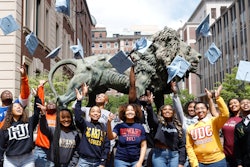After the U.S. Supreme Court ended race-conscious college admissions policies in June, focus turned to searching for alternatives. Seemingly everything from using class-based preferences to ditching legacy admissions to replacing admittance regimes with lottery systems has been suggested. But can these race-neutral means allow colleges and universities to maintain their current levels of diversity? Here is a look at some more common ideas offered up with the latest evidence on whether the measures can maintain enrollment rates among students from underrepresented backgrounds.
Socioeconomic status
One of the most proposed alternatives to race-conscious admissions is to use socioeconomic status (SES) instead — to give an advantage to students from families with less money. Race and SES are deeply intertwined, and so the argument goes, focusing on wealth would benefit students from underrepresented backgrounds. However, research has repeatedly shown that even aggressive admissions policies based on SES fail to generate as much diversity as policies that use race.
In the most recent study, performed by the Georgetown University Center on Education and the Workforce (CEW), researchers simulated admissions policies that used SES in combination with factors such as high school class rank, grades, and standardized test scores. The results revealed that, in models ignoring race and ethnicity, percentages of underrepresented minorities at selective schools dropped.
There may be multiple reasons for these outcomes. Though many underrepresented groups are collectively ‘worse off’ economically than white and Asian applicants, there are still plenty of economically disadvantaged whites and Asians who would receive admissions benefits under any SES policy.
 Dr. Zack Mabel
Dr. Zack Mabel
Another factor is that, because of structural racism, white families often have educational advantages that Black families do not enjoy, even if they have the same net worth. White families, including those a low net worth, are less likely than Black families to live in impoverished neighborhoods. In these neighborhoods, schools tend to have fewer resources, and there are more likely to be environmental hazards like lead paint, asbestos, and toxic waste that can impact learning. Thus, students from white families may appear to demonstrate higher levels of academic merit than Black peers with similar economic status.
“Just because you have a low income, it doesn’t mean that race doesn’t still matter,” said Dr. Dominique Baker, an associate professor at Southern Methodist University.
Top 10% plans
Another alternative attempts to take advantage of the school segregation that already exists in America. Top 10% plans aim to create diversity by giving the top 10% (or a similar percentage) of students at each high school in an area automatic admission to one or several in-state colleges. Because acceptances go out to the top students at every high school, including those with higher percentages of underrepresented minorities, the hope is that larger percentages of those students will matriculate.
The plans have been popular in states where race-conscious admissions have been previously banned, including Texas, California, and Florida. However, although the specific details of each plan differ, they have not resulted in college classes as diverse as those assembled under race-conscious policies at flagship institutions.
“If affirmative action across the public university system tended to increase Black and Hispanic enrollment by about 20%, top 10% plans tend to increase Black and Hispanic enrollment by something like 4%, maybe 5%,” said Dr. Zachary Bleemer, assistant professor at Princeton University.
A 2020 study examining 18 years of data from Texas’s top 10% plan found little to no equity-producing effects of the plan at state flagship schools. The high schools that were sending the most students to those colleges before the plan continued to dominate, dwarfing the representation from schools with more minority students.
One of several potential drivers of these results may be that there is not enough segregation in America for the plans to work, according to Mabel.
“Very, very few states have extreme enough racial segregation between high schools for top 10% plans to generate racial and ethnic diversity,” said Mabel.
Another reason is that the high schools that were not sending many students to the flagships may not have had strong college-going cultures.
“It’s a lot easier to see yourself going to college if a lot of your peers are also going to college out of your high school,” said Dr. Daniel Klasik, an associate professor at the University of North Carolina-Chapel Hill and one of the authors of the 2020 study. “It may be that these high schools that didn’t have prior sending patterns to the Texas flagships just didn’t have a strong pattern of sending students to college in general.”
A final reason is that, even though colleges were accepting them automatically, students from underrepresented backgrounds might not have been confident that they would be comfortable at those schools.
“Just because an institution said that you have automatic admissions, [it] doesn’t mean that a student thinks that they would be welcome at that college,” Baker explains. “Student belongingness isn’t a guarantee just because you were accepted. It takes work to ensure that students know that they belong and that it’s genuine.”
The point is especially relevant in light of the attacks on DEI efforts taking place on campuses around the country, which may bring into question whether some students from an underrepresented background feel welcome.
Lotteries
Another proposed alternative to race-conscious admissions stands out for its boldness. What if schools eliminated their attempts to make fine distinctions among applicants and simply conducted a lottery for every student over a certain threshold — a particular grade-point average or SAT score, for example? All of the students randomly selected from the pool would gain admittance. Advocates praise the idea for simplifying the application process (which can be a particular challenge for underrepresented students) and disconnecting college admissions from the specious idea of merit.
However, a study co-led by Baker found that the vast majority of simulated lotteries caused the percentages of students of color admitted to selective universities to drop, in some cases to less than 2% of the entering class. The reason is simple. The lottery results, though random, inevitably reflect the inequities of the methods used to form the pool, such as SAT scores and GPAs.
 Dr. Zachary Bleemer
Dr. Zachary Bleemer
Baker and co-author Michael Bastedo also found that, due to the inherent randomness of the process, percentages of underrepresented groups varied wildly from year to year, even if the qualification for the lottery pool was a high school diploma or GED.
“One year, you have 10% of your students who are Black, and the next year, 1% of your students are Black,” said Baker. “That is not ideal.”
Other proposals
Eliminating admissions preferences comes among several other policies proposed as alternatives. Admissions preferences are likely to favor the privileged, including advantages for legacies, athletes, the children of donors, and the children of faculty and staff. Baker calls this “useful morally and ethically,” but doubts it would have a large impact on diversity. A study of Harvard University found that the impact of eliminating legacy and athlete preferences would be roughly equivalent to that of a top 10% plan. A relatively small number of applicants benefit from these preferences, and unless a school had other policies in place, those applicants likely would be replaced by other demographically similar applicants.
Other common ideas include reducing the emphasis on standardized tests, the creation of adversity scores to measure a student’s circumstances, and for colleges to increase outreach to underserved high schools. While experts broadly agreed that these steps could be helpful, no one suggested they would be able to maintain current levels of diversity on their own.
Nonetheless, even if a school combined every policy discussed here, experts doubt they could stave off a diversity decline.
“If you look at California, Texas, and Michigan [where race-conscious admissions had previously been banned], all of those flagship schools have implemented most or all of these policies and still haven’t returned to the level of diversity relative to the high school population that they had under race-based affirmative action,” said Bleemer.
Klasik said he expects the enrollment of underrepresented racial minorities at selective schools to drop by around 20%.
“It’s simple logic,” Klasik said. “If you’re trying to maximize your racial and ethnic diversity, the best thing you can do is look at a student’s race or ethnicity. These [other] methods are dead at the door.”















